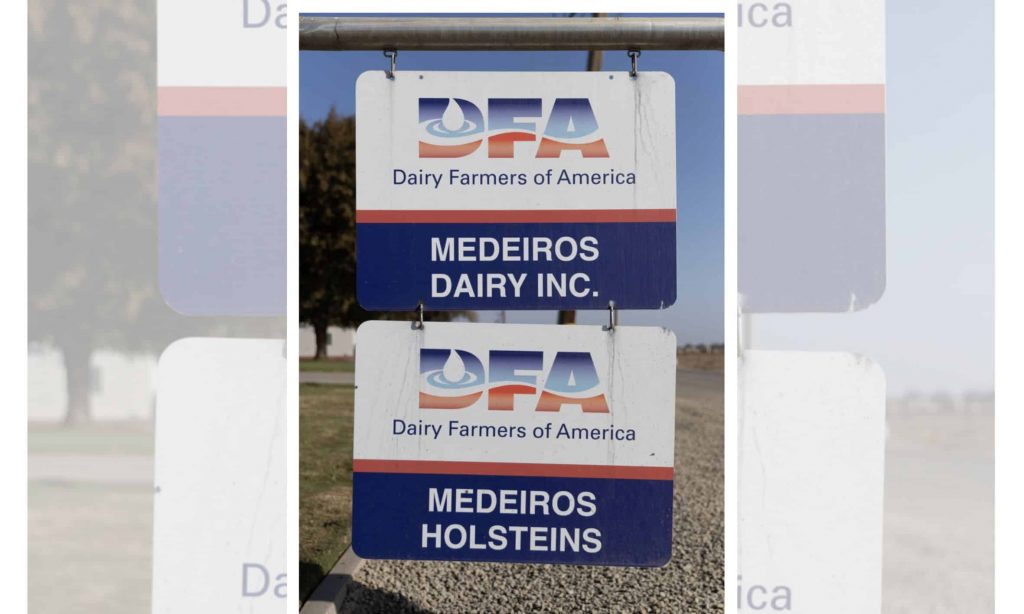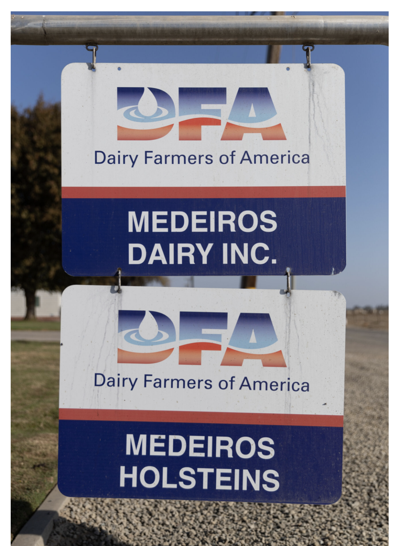Vidovich continues with a plan to build a beef harvesting plant near Lemoore.


Also on the sales block is the 52-year strong Alvaro Machado Dairy of Hanford with a date set for Sept. 29 for auction.
While feed costs this past year have not relented much, Kings County dairies have seen smaller milk checks based on a collapsing milk price, falling from $26.30 per cwt in 2022 — based on the just-released Kings County Crop Report — to around $14 earlier this summer. Prices have improved about $1.50 since, says Hanford dairyman Joaquin Contente.
Dairymen are paid different prices for their milk based on what the milk goes for — be it milk, cheese, butter or dried powder. Prices vary by class under a USDA formula. In the cheese category, not all varieties are treated the same, argues Contente.
California Farm Bureau has written, “Nearly five years after joining the federal milk marketing order, California dairy farmers will have a chance to weigh in on proposed changes to how milk should be priced, with potential impacts to their take-home pay.”

Contente focused recently on mozzarella cheese at an August USDA hearing with a plan to increase profitability for struggling dairies.
Italian-inspired mozzarella is now the top-selling cheese in America — a favorite on pizza and with pasta dishes. In 2022, around 4.6 billion pounds of mozzarella were produced in the United States.
In 2022, around 3.96 billion pounds of cheddar cheese were produced here, down slightly from the previous year. Mozzarella surpassed cheddar as America’s most popular cheese for the second year in a row. Despite the recent decrease in cheddar consumption, the two cheeses together account for 63 percent of cheese availability.
California mozzarella production has simply skyrocketed in recent decades from almost nothing in 1990 to 1.5 billion pounds in 2019. There were 28 plants producing Mozzarella in California in 2019. The largest is in Lemoore, the privately-held Leprino with two plants in town and some 1,300 employees.
Leprino is the world’s largest maker of mozzarella cheese. Recently, the company launched more production out of state in New Mexico and in Texas with a new plant in Lubbock, Texas is scheduled to be fully operational in 2025.
Despite its rocketing increase in popularity, Contente and his organization, The California Dairy Campaign, testified that dairymen are not properly compensated for the value of milk made into this cheese.
“The federal milk marketing order system exists to protect dairy farmers from dairy processors. As changes to federal order pricing are considered during this hearing, it is essential to recognize the foundational importance of federal order regulations to establish minimum prices paid to dairy producers.”
California Dairy Campaign proposed the hearing to add mozzarella to the Class III pricing formula so that producer prices paid are more market-oriented, he argues.
“The Class III price sank to $13.77 per cwt in July. If mozzarella is added to the Class III formula, dairy producers would be paid prices based on higher moisture and higher yield mozzarella cheese, a growing segment of the cheese market that has already surpassed cheddar cheese in US cheese production and is expected to continue strong and steady growth.”
Contente suggests not including mozzarella in the Class III formula means dairymen are “leaving about $1 billion on the table.”
The organization has submitted a proposal to add mozzarella to the protein price formula. Currently, the Class III price is based on the Chicago Mercantile Exchange cheddar block and barrel price, which they describe as “incredibly volatile.”
Also, the California Dairy Campaign opposed proposals submitted by the International Dairy Foods Association (IDFA), National Milk Producers Federation (NMPF), and the Wisconsin Cheese Makers Association to increase the make allowance or manufacturing cost allowance dairy farmers pay to dairy processors to process milk.
The proposals would increase current Class III ($3.17 per cwt) and Class IV ($2.17 per cwt), make allowances by 20 to 60 percent. The increases are based on voluntary, unaudited cost surveys put forward by dairy processors. The proposals could increase the Class III make allowance to $3.80 to $5.00 per cwt and Class IV to $2.60 to $3.47 per cwt.
Contente testified: “Milk handlers need to look further up the food chain to cover their costs, not carve out higher make allowances from dairy producer milk checks. A proposal to update the make allowance more frequently is even more concerning.”
A change in the Class III formula may help Kings dairy operators in the future if the USDA accepts Contente’s arguments — but it is too late for the two dairy families who’ll give up their farms soon.
So what happens to these small dairy farms after the auction?
Locally one trend we have seen is led by investor John Vidovich who has purchased several local diaries that have closed. The facilities are run by Vidovich associate Jim Wilson as heifer ranches. Heifers are female cattle who have yet to give birth. Heifers are raised on the farm until they reach the appropriate age and weight to reproduce. Once the heifer has had her first calf, she then becomes a cow.
These days the focus of these operations are the profitability from beef sales with live cattle prices having doubled since 2020.
A recent Milk Producers Council newsletter explains this trend.
“Amidst mediocre milk prices, the brightest spot on dairy producers’ income statements is their beef revenue. It got another boost this week, as CME live cattle and feeder cattle futures reached new life-of-contract highs. Every animal on the farm is worth significantly more than it was in the past. That’s likely to spur continued interest in beef crossbreeding programs and pull more dairy heifers into beef feedlots. There is a beef packer with deep pockets at every dairy sale, ensuring that some dairy cows are rushed to slaughter. The beef industry is chronically short of cattle and looking to dairy to fill the vacuum. Lofty beef prices are trimming the dairy cattle supply from all directions, and they’re reducing milk production prospects at the margins.”
Vidovich continues with a plan to build a beef harvesting plant near Lemoore.
Legal notice about Intellectual Property in digital contents. All information contained in these pages that is NOT owned by eDairy News and is NOT considered “public domain” by legal regulations, are registered trademarks of their respective owners and recognized by our company as such. The publication on the eDairy News website is made for the purpose of gathering information, respecting the rules contained in the Berne Convention for the Protection of Literary and Artistic Works; in Law 11.723 and other applicable rules. Any claim arising from the information contained in the eDairy News website shall be subject to the jurisdiction of the Ordinary Courts of the First Judicial District of the Province of Córdoba, Argentina, with seat in the City of Córdoba, excluding any other jurisdiction, including the Federal.
1.
2.
3.
4.
5.
eDairy News Spanish
eDairy News PORTUGUESE
